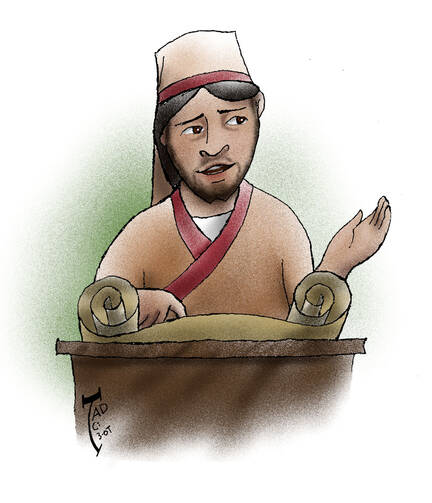Proclaim the Good Word
The broad context for Ezra’s reading of the Law of Moses to the people “before the Water Gate” is the return from the exile in Babylon and the reconstruction of the religious life of the people of Israel. This reconstruction included rebuilding the Temple but also rebuilding the knowledge of God’s law. The people are hearing the commandments of God, newly codified, for the first time.
The scene at the Water Gate is a public assembly in which the law was proclaimed to and heard by all the people. Public promulgation of the law was necessary in antiquity, when many people could not read and even those who could read would not have possessed a copy of the text. In fact, many codes of law, not as voluminous as the laws of modern nation states, were made public in the city square on a stone stele, like the law code of Hammurabi, so people could know the laws.
Public proclamation was a sort of ancient Internet, bringing the law to all the people and creating a sense of communal accountability. And Ezra was speaking to all people, “both men and women and all who could hear with understanding,” an inclusiveness that is significant since it is repeated twice in Nehemiah. The last group, “all who could hear with understanding,” included children, probably all those above age 7, as that was considered the age of reason.
The lengthy public reading, “from early morning until midday,” was not just to acquaint people with the law; it also had a didactic function, since the reading from the law of God was accompanied by interpretation. Ezra, and those who taught with him, “gave the sense, so that the people understood the reading.” This is an early example of what is found later in the synagogue and then adopted by the church: the proclamation of God’s word accompanied by an explanation so that all might understand the meaning of God’s word.
It was the task of Ezra as priest and scribe to build the people up by interpreting God’s word, a task that would later fall to rabbis and priests. Ezra’s proclamation led the people to mourn, but Nehemiah, Ezra and the Levites, all of whom were involved in teaching the law, encouraged the people not to weep. Their weeping arose from a conviction of sinfulness based on a lack of knowledge of God’s law, not a rejection of it, so the teachers of the people encouraged them instead to take joy in what they had heard and to celebrate with a feast. God’s law is intended to lead to joy, not misery.
For Luke, the proclamation of the Scripture by Jesus is so significant that he places it at the beginning of Jesus’ ministry. Luke places this scene in Chapter Four in order to start Jesus’ ministry with his proclamation of the prophet Isaiah in the synagogue, unlike Mark and Matthew, where much of Jesus’ mission has already occurred before Jesus returns to Nazareth. This allows Luke to present Jesus as a new Ezra reading and interpreting Scripture for all the people.
But in Nazareth, his hometown, Jesus’ interpretation of Scripture, so central to the life of the Jewish people from the time of Ezra and before, takes on a new dimension, one never seen before in the teaching of God’s people. As Jesus proclaimed the good word for the people, reading from the scroll of the prophet Isaiah, he explains Scripture by reference to himself, saying, “Today this Scripture has been fulfilled in your hearing.” Jesus’ interpretation is to identify himself as the one who fulfills the promises of God in Scripture.
It is a bold and shocking declaration, which reorients the interpretation of Scripture for Jesus’ disciples. Jesus’ explanation means that Christians everywhere interpret the word of God through the clarifying lens of Christ. As the church, our task is still the same as that of Ezra and the gathered people of Israel: to hear God’s word proclaimed, to ponder it and to listen. But we do so as the church, listening for the voice and guidance of the Messiah, the one who interpreted the Scripture with his life and death.
This article also appeared in print, under the headline “Proclaim the Good Word,” in the January 18-25, 2016, issue.








